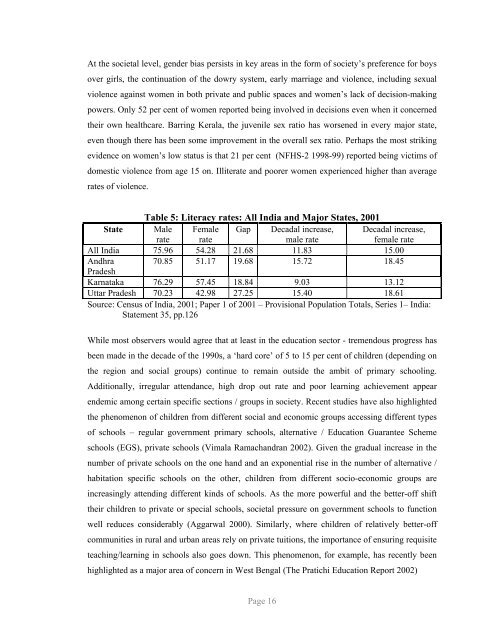Snakes and Ladders - ERU Consultants Pvt. Ltd.
Snakes and Ladders - ERU Consultants Pvt. Ltd.
Snakes and Ladders - ERU Consultants Pvt. Ltd.
You also want an ePaper? Increase the reach of your titles
YUMPU automatically turns print PDFs into web optimized ePapers that Google loves.
At the societal level, gender bias persists in key areas in the form of society’s preference for boys<br />
over girls, the continuation of the dowry system, early marriage <strong>and</strong> violence, including sexual<br />
violence against women in both private <strong>and</strong> public spaces <strong>and</strong> women’s lack of decision-making<br />
powers. Only 52 per cent of women reported being involved in decisions even when it concerned<br />
their own healthcare. Barring Kerala, the juvenile sex ratio has worsened in every major state,<br />
even though there has been some improvement in the overall sex ratio. Perhaps the most striking<br />
evidence on women’s low status is that 21 per cent (NFHS-2 1998-99) reported being victims of<br />
domestic violence from age 15 on. Illiterate <strong>and</strong> poorer women experienced higher than average<br />
rates of violence.<br />
Table 5: Literacy rates: All India <strong>and</strong> Major States, 2001<br />
State Male Female Gap Decadal increase, Decadal increase,<br />
rate rate<br />
male rate<br />
female rate<br />
All India 75.96 54.28 21.68 11.83 15.00<br />
Andhra<br />
Pradesh<br />
70.85 51.17 19.68 15.72 18.45<br />
Karnataka 76.29 57.45 18.84 9.03 13.12<br />
Uttar Pradesh 70.23 42.98 27.25 15.40 18.61<br />
Source: Census of India, 2001; Paper 1 of 2001 – Provisional Population Totals, Series 1– India:<br />
Statement 35, pp.126<br />
While most observers would agree that at least in the education sector - tremendous progress has<br />
been made in the decade of the 1990s, a ‘hard core’ of 5 to 15 per cent of children (depending on<br />
the region <strong>and</strong> social groups) continue to remain outside the ambit of primary schooling.<br />
Additionally, irregular attendance, high drop out rate <strong>and</strong> poor learning achievement appear<br />
endemic among certain specific sections / groups in society. Recent studies have also highlighted<br />
the phenomenon of children from different social <strong>and</strong> economic groups accessing different types<br />
of schools – regular government primary schools, alternative / Education Guarantee Scheme<br />
schools (EGS), private schools (Vimala Ramach<strong>and</strong>ran 2002). Given the gradual increase in the<br />
number of private schools on the one h<strong>and</strong> <strong>and</strong> an exponential rise in the number of alternative /<br />
habitation specific schools on the other, children from different socio-economic groups are<br />
increasingly attending different kinds of schools. As the more powerful <strong>and</strong> the better-off shift<br />
their children to private or special schools, societal pressure on government schools to function<br />
well reduces considerably (Aggarwal 2000). Similarly, where children of relatively better-off<br />
communities in rural <strong>and</strong> urban areas rely on private tuitions, the importance of ensuring requisite<br />
teaching/learning in schools also goes down. This phenomenon, for example, has recently been<br />
highlighted as a major area of concern in West Bengal (The Pratichi Education Report 2002)<br />
Page 16












